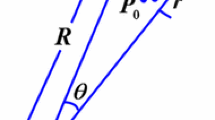Abstract
In this paper, an improved efficient population utilization strategy for particle swarm optimization (IEPUS-PSO) for high dimension problem is proposed to estimate defect profile from magnetic flux leakage (MFL) signals. In the IEPUS-PSO, a mutation probability is proposed to distinguish local version and global version in particle change model and a self-adapted mutation operator, which is used to update the particles’ positions randomly, is introduced into EPUS-PSO. The IEPUS-PSO- based inversing technique is used to estimate the defect profiles. The estimated defect profiles of simulation signals demonstrate that the inversing technique based on the IEPUS-PSO outperforms the one based on EPUS-PSO. The results estimated from real MFL signals by the IEPUS-PSO-based inversing technique indicate that the algorithm is capable of decreasing the computation time. The results show that the IEPUS-PSO-based inversing technique could improve the reconstruction precision by two orders of magnitude for the MFL simulation signals, and for the real MFL signals, the computation time is reduced by about 30% nearly under the same reconstruction precision.
Similar content being viewed by others
References
Zhongli Ma and Hongda Liu, Pipeline defect detection and sizing based on MFL data using immune RBF neural networks, CEC 2007, IEEE Congress, 2007, pp. 3399–3403.
Chen, L., Peiwen Que, and Jin, T., A giant-magnetoresistance sensor for magnetic-flux-leakage nondestructive testing of a pipeline, Russ. J. Nondestr. Test., 2005, vol. 41, no. 7, pp. 462–465.
Xiaochun Song, Song-Ling Huang, and Zhao Wei, Optimization of the magnetic circuit in the MFL inspection system for storage-tank floors, Russ. J. Nondestr. Test., 2007, vol. 43, no. 5, pp. 326–331.
Kim, J.W., Lee, C., Park, S., and Lee, J.J., Magnetic flux leakage-based steel cable NDE and damage visualization on a cable climbing robot, Proc. SPIE Int. Soc. Opt. Eng., 2012, vol. 8345.
Christen, R., Bergamini, A., and Motavalli, M., Influence of steel wrapping on magneto-inductive testing of the main cables of suspension bridges, NDT E Int., 2009, vol. 42, no. 1, pp. 22–27.
Ramuhalli, P., Udpa, L., and Udpa, S.S., Electromagnetic NDE signal inversion by function-approximation neural networks, IEEE Trans. Magnet., 2002, vol. 38, no. 6, pp. 3633–3642.
Chao Xu, Changlong Wang, Fengzhu Ji, and Xichao Yuan, Finite-element neural network-based solving 3-d differential equations in MFL, IEEE Trans. Magnet., 2012, vol. 48, no. 12, pp. 4747–4756.
Dutta, S.M., Ghorbel, F.H., and Stanley, R.K., Dipole modeling of magnetic flux leakage, IEEE Trans. Magnet., 2009, vol. 45, no. 4, pp. 1959–1965.
Dutta, S.M., Ghorbel, F.H., and Stanley, R.K., Simulation and analysis of 3-D magnetic flux leakage, IEEE Trans. Magnet., 2009, vol. 45, no. 4, pp. 1966–1972.
Zhang, Y., Ye, Z., and Wang, C., A fast method for rectangular crack sizes reconstruction in magnetic flux leakage testing, NDT Int., 2009, vol. 42, no. 5, pp. 369–375.
Priewald, R.H., Magele, C., Ledger, P.D., Pearson, N.R., and Mason, J.S.D., Fast magnetic flux leakage signal inversion for the reconstruction of arbitrary defect profiles in steel using finite elements, IEEE Trans. Magnet., 2013, vol. 49, no. 1.
Guoguang, Z. and Jing, L., Finite element modeling of circumferential magnetic flux leakage inspection in pipeline, Proc. Int. Conf. Intelligent Computation Technology and Automation (ICICTA’10) (Changsha, China, 2010), pp. 327–330.
Song Qiang, Interacting effects of clustering defects on MFL signals using FEA, Insight, 2013, vol. 55, pp. 558–560.
Chao Xu, Changlong Wang, Fengzhu Ji, and Xichao Yuan, Finite-element neural network-based solving 3-D differential equations in MFL, IEEE Trans. Magnet., 2012, vol. 48, no.12.
Joshi, A., Udpa, L., Udpa, S., and Tamburrino, A., Adaptive wavelets for characterizing magnetic flux leakage signals from pipeline inspection, IEEE Trans. Magnet., 2006, vol. 42, no.10.
Hari, K.C., Nabi, M., and Kulkarni, S.V., Improved fem model for defect-shape construction from MFL signal by using genetic algorithm, IET Sci. Meas. Technol., 2007, vol. 1, no. 4, pp. 196–200.
WenHua Han, Ping Yang, Fei Xia, and Yang Xue, Magnetic flux leakage signal inversion of corrosive flaws based on modified genetic local search algorithm, J. Shanghai Jiaotong Univ. (Sci.), 2009, vol. 14 (E), no. 2, pp. 168–172.
Eberhart, R.C. and Kennedy, J., A new optimizer using particle swarm theory, Proc. 6th Int. Symp. Micro Mach. Human Sci. (Nagoya, Japan, 1995), pp. 39–43.
van den Bergh, F. and Engelbrecht, A.P., A cooperative approach to particle swarm optimization, IEEE Trans. Evol. Comput., 2004, vol. 8, no. 3, pp. 225–239.
Hsieh, S.T., Sun, T.Y., Liu, C.C., and Tsai, S.J., Efficient population utilization strategy for particle swarm optimizer, IEEE Trans. System, Man, Cybernetics B: Cybernetics, 2009, vol. 39, no. 2.
LiJue Liu, ZiXing Cai, and Hong Chen, Immunity clone algorithm with particle swarm evolution, J. Central South Univ. Technol., 2006, vol. 13, no. 6, pp. 703–706.
Author information
Authors and Affiliations
Corresponding author
Additional information
Published in Russian in Defektoskopiya, 2017, No. 12, pp. 46–56.
The article was translated by the authors.
Rights and permissions
About this article
Cite this article
Han, W., Wu, Z., Zhou, M. et al. Magnetic Flux Leakage Signal Inversion Based on Improved Efficient Population Utilization Strategy for Particle Swarm Optimization. Russ J Nondestruct Test 53, 862–873 (2017). https://doi.org/10.1134/S1061830917120075
Received:
Accepted:
Published:
Issue Date:
DOI: https://doi.org/10.1134/S1061830917120075




